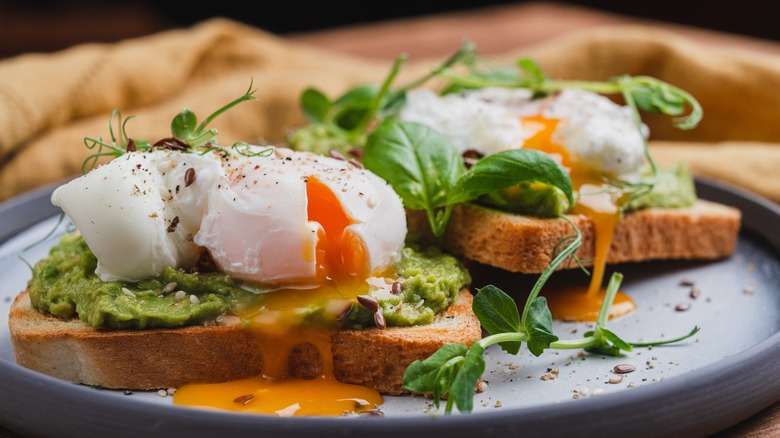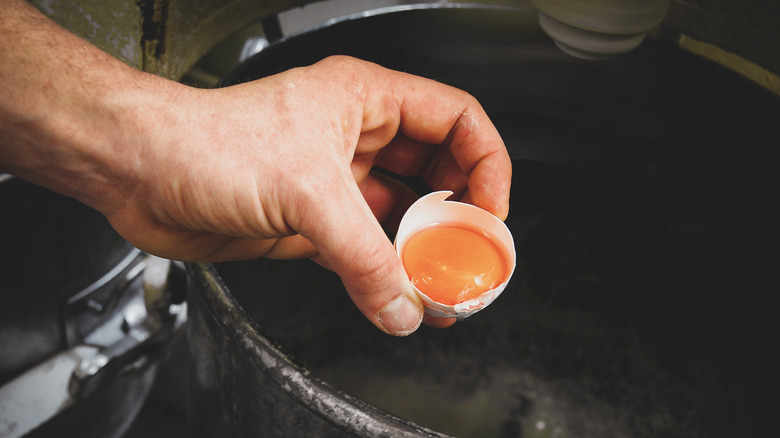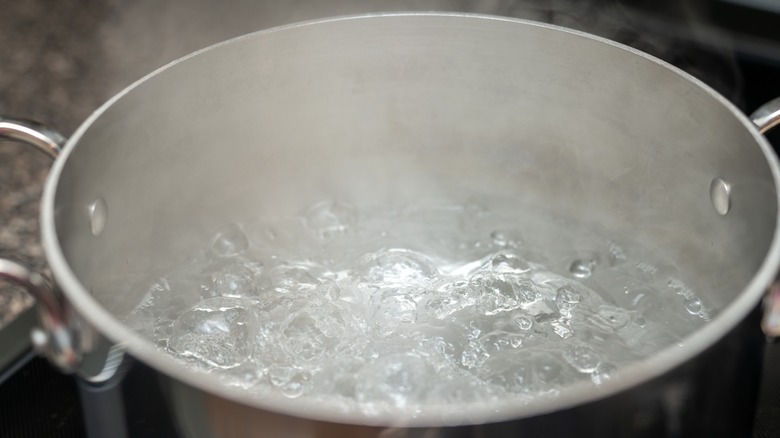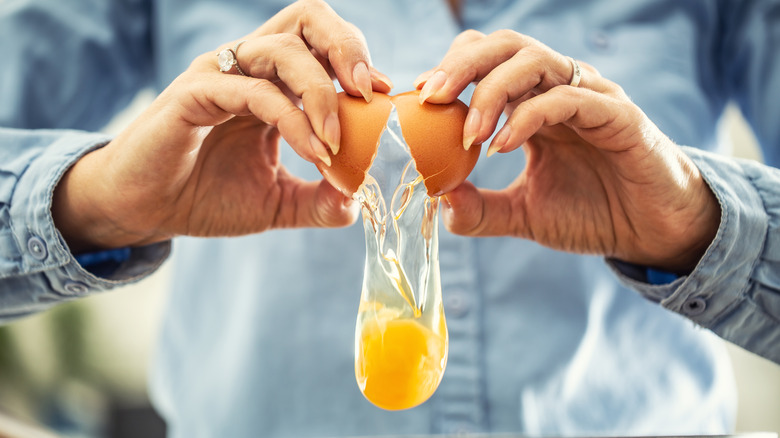New To Making Eggs Benedict? Remember These Expert Tips
The precise origins of eggs Benedict can be tricky to pinpoint — some attribute the creation of the dish to a frequent customer at New York's Delmonico's restaurant while others credit a Wall Street stockbroker in search of a hangover cure. However, there's no question that it has become a regular item on breakfast and brunch tables around the world. Made up of poached eggs placed delicately on top of toasted English muffins and topped with a lemony hollandaise sauce, eggs Benedict is an impressive dish that looks more complicated than it actually is to put together.
We spoke to chef Nelson Serrano-Bahri, the Director of Innovation at the American Egg Board, for tips that will make things easier on people new to preparing eggs Benedict. With a guided approach, poaching eggs and assembling traditional eggs Benedict becomes more approachable, even on hectic weekday mornings. "For beginners, I recommend a few tips to make the process easier as they begin making eggs Benedict," Serrano-Bahri graciously offered. With his guidance in mind, you may find yourself digging into servings of savory, saucy eggs Benedict with increasing regularity.
Organize your kitchen
Before you begin to toast bread or poach eggs, Nelson Serrano-Bahri suggests tidying up your kitchen space before you start to cook. "Organize your ingredients beforehand," he guides. "To ensure an easier cooking experience, I recommend starting with a mental 'mise en place' preparation session to make sure you have all your ingredients and equipment ready." This prepared approach to cooking is a common strategy used by professional chefs and can not only ensure you have all the ingredients you need at the exact moment you need them, but will also help keep areas clean. Use a muffin tin to hold spices and herbs and keep eggs in place as you fire up the stovetop.
"Don't forget to have a few extra eggs on hand as you practice your poached eggs technique," Serrano-Bahri helpfully adds. Perfectly poached eggs can take a few tries to get right, and if you're cooking for guests you'd like to impress, giving yourself a few extra chances can help take the pressure off as you work to set aesthetically-pleasing plates onto the kitchen table.
Choose the right cooking vessel
With ingredients needed to make eggs Benedict neatly set out, Nelson Serrano-Bahri wants aspiring at-home cooks to direct their attention to the pots and pans used to boil water and poach the eggs. "Select the right cooking vessel," he directs. "You want to have a big and deep vessel to poach your eggs in so that the eggs are fully submerged under water, but not touching the bottom of the pan." This kind of attention is what you need if you're looking to make fool-proof poached eggs.
When choosing which container to use, consider the height of the pot itself. "For every one to two inches of the pan's height, you should add in one egg," Serrano-Bahri clarifies. While you might think cooking eggs in water is a straight-forward process, the approach take can change the consistency and texture of the eggs you fish out of the water. From not using fresh eggs to cracking eggs directly into the water, there are plenty of egg-poaching mistakes beginning cooks might inadvertently make, and using a too-shallow pan shouldn't be one.
Pay attention to the water
With the right pot selected for your egg-poaching attempts, Nelson Serrano-Bahri's next recommendation involves the actual water used for the poaching process. "Prep your water," he instructs. "Bring your water up to about 180 to 190 degrees before adding your eggs." As tempting as it might be to dump eggs quickly into the water once it reaches a boiling roll, heed Serrano-Bahri's instructions. "Water shouldn't be boiling when you add your water, with very minor bubbles if any," he guides.
Before placing cracked eggs into the water, Serrano-Bahri offers another helpful tip used by professional chefs. "Add a small amount of vinegar — approximately one tablespoon of vinegar per every cup of water — to your water to help protect the yolk when poaching," he offers. If you have the time, a vinegar soak can also help set the outer layer of the egg's protein and keep the egg intact as it cooks. You may also want to add a pinch of salt to the water before setting eggs into their warm bath. "You can also add some salt to your water for some extra flavor," Serrano-Bahri clarifies.
Get the eggs ready
Once your salted water has reached the appropriate temperature, it's time to get ready for the big moment of plopping eggs into the pot — just hold off before you start cracking eggs on your counter and dropping them into the water. "Prep your eggs," Nelson Serrano-Bahri warns. "Before beginning your poaching process, I recommend cracking your eggs into a separate round edged vessel like a cereal bowl. Doing this beforehand eliminates leftover shells." Not only can using a separate container to hold the eggs help you spot sneaky shells, the separate bowl can also help you slide raw eggs more easily into the hot water.
If you think you can simply drop eggs into water to cook, think again. Small hacks like creating movement in the water can increase the chances that you'll have perfectly poached eggs to plate. "Once your eggs are ready, stir the water gently to form a vortex in the center of the pan," says Serrano-Bahri. "Tip your vessel with the cracked eggs into the water and slowly slide the egg into the pan to begin the poaching process." You're well on your way to playing the dish.
Practice makes perfect
Nelson Serrano-Bahri recognizes that all of this work can take some time to get right. "Practice your poaching," he encourages. "Poaching takes practice!" With so many areas in which mistakes can be made, it is understandable to see how novice chefs can get discouraged. After you've set the eggs inside of the water, keep an eye on your watch. "I recommend poaching your eggs for about 2 to 3 minutes," Serrano-Bahri offers. "Pull the eggs out immediately, put them through a strainer, dry them and then serve."
For cooks just starting to learn their way around a kitchen, Serrano-Bahri suggests starting out slowly until you begin to feel more comfortable with the process. "Try not to add too many eggs when poaching and always remember to add one egg at a time to the pan," he warns. With Serrano-Bahri's advice in mind, you can try different methods of poaching eggs so that when friends stop by unannounced for Saturday brunch, you have plenty of pretty eggs to plate on top of toasted homemade English muffins and douse in hollandaise sauce.





